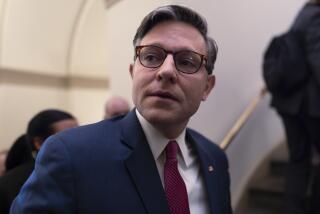Op-Ed: Congress can give every American a pony (if it breeds enough ponies)

In 1860, Abraham Lincoln’s campaign slogan was “Vote Yourself a Farm.” In 1900, William McKinley promised “A Full Dinner Plate.” And in 1928, Herbert Hoover won a landslide victory pledging “A Chicken in Every Pot and a Car in Every Garage.” A free farm, a full belly and a shiny new car. Today’s Republicans would cringe at the thought of such rhetoric from their party’s nominees. As Ronald Reagan taught, the government is your problem, not the solution to your problems.
Democrats might blanch too, but for different reasons. They still believe in the power of government to solve problems, but they’ve absorbed the idea that everything must be “paid for.” Their 2016 nominee is a case in point. In her new book, Hillary Clinton mocks Sen. Bernie Sanders’ populist agenda.
For the record:
11:25 a.m. Oct. 2, 2017Due to a problem with how the Times’ publishing software represented the author’s math equation, it required an extra set of parentheses to read correctly, now added.
BERNIE: I think America should get a pony.
HILLARY: How will you pay for the pony?
You might find Clinton’s question intuitively reasonable. If you promise to fight for big things, then you should draw a detailed road map to the treasure chest that will fund them all. After all, the money has to come from somewhere.
Are you telling me that the government can just make money appear out of nowhere, like magic? Absolutely.
But what if I told you that your intuition was all wrong? What if it turned out that the government really could give everyone a pony — and a chicken and car? That is, so long as we could breed enough ponies and chickens and manufacture enough cars. The cars and the food have to come from somewhere; the money is conjured out of thin air, more or less.
Let me explain.
In school, you were probably taught the order of operations, or PEMDAS: Parentheses, Exponents, Multiplication, Division, Addition, Subtraction. That mnemonic helps you handle tricky equations like this one:
(3^7 — 2 (150+136)) / (5^5 — 17 x 100).*
When Clinton asks where the money will come from, she’s ordering the government’s fiscal operations like so:
1. Government collects money from us in the form of taxes (T)
2. Government figures out how much it wants to spend and then borrows any additional money it needs (B)
3. Government spends the money it has collected (S)
Since none of us learned any differently, most of us accept the idea that taxes and borrowing precede spending – TABS. And because the government has to “find the money” before it can spend in this sequence, everyone wants to know who’s picking up the tab.
There’s just one catch. The big secret in Washington is that the federal government abandoned TABS back when it dropped the gold standard. Here’s how things really work:
1. Congress approves the spending and the money gets spent (S)
2. Government collects some of that money in the form of taxes (T)
3. If 1 > 2, Treasury allows the difference to be swapped for government bonds (B)
In other words, the government spends money and then collects some money back as people pay their taxes and buy bonds. Spending precedes taxing and borrowing – STAB. It takes votes and vocal interest groups, not tax revenue, to start the ball rolling.
If you need proof that STAB is the law of the land, look no further than the Senate’s recent $700-billion defense authorization. Without raising a dime from the rest of us, the Senate quietly approved an $80-billion annual increase, or more than enough money to make 4-year public colleges and universities tuition-free. And just where did the government get the money to do that? It authorized it into existence.
Whoa, cowboy! Are you telling me that the government can just make money appear out of nowhere, like magic? Absolutely. Congress has special powers: It’s the patent-holder on the U.S. dollar. No one else is legally allowed to create it. This means that Congress can always afford the pony because it can always create the money to pay for it.
Now, that doesn’t mean the government can buy absolutely anything it wants in absolutely any quantity at absolutely any speed. (Say, a pony for each of the 320 million men, women and children in the United States, by tomorrow.) That’s because our economy has internal limits. If the government tries to buy too much of something, it will drive up prices as the economy struggles to keep up with the demand. Inflation can spiral out of control. There are plenty of ways for the government to get a handle on inflation, though. For example, it can take money out of the economy through taxation.
Clinton’s pony was a metaphor for the big-ticket items on Sanders’ agenda. Namely, tuition-free college and Medicare for all. Putting a fiscal twist on Nancy Reagan’s famous catchphrase, Clinton scoffed at the price tag and warned voters to Just Say Neigh. But Americans still like Sanders’ ideas: 63% support free tuition and 66% support Medicare for all. To make these policies work, all we have to do is produce enough hospitals, doctors, nurses, universities and teachers. Just imagine how high those poll numbers would climb if everyone understood how easy it would be for Congress to pony up.
Stephanie Kelton is a professor of public policy and economics at SUNY Stony Brook. She served as chief economist on the U.S. Senate Budget Committee in 2015 and was an economic advisor to the Bernie Sanders 2016 presidential campaign. *The solution to her math problem is 1615/1425 or, in letters, PO/NY.
Follow the Opinion section on Twitter @latimesopinion or Facebook
ALSO
Nikki Sixx: Take it from a former addict, a lot more could be done to end the opioid crisis
Republicans and the rule of law? Save us from the sanctimony
The NBA is turning its players into running, jumping billboards
More to Read
A cure for the common opinion
Get thought-provoking perspectives with our weekly newsletter.
You may occasionally receive promotional content from the Los Angeles Times.










